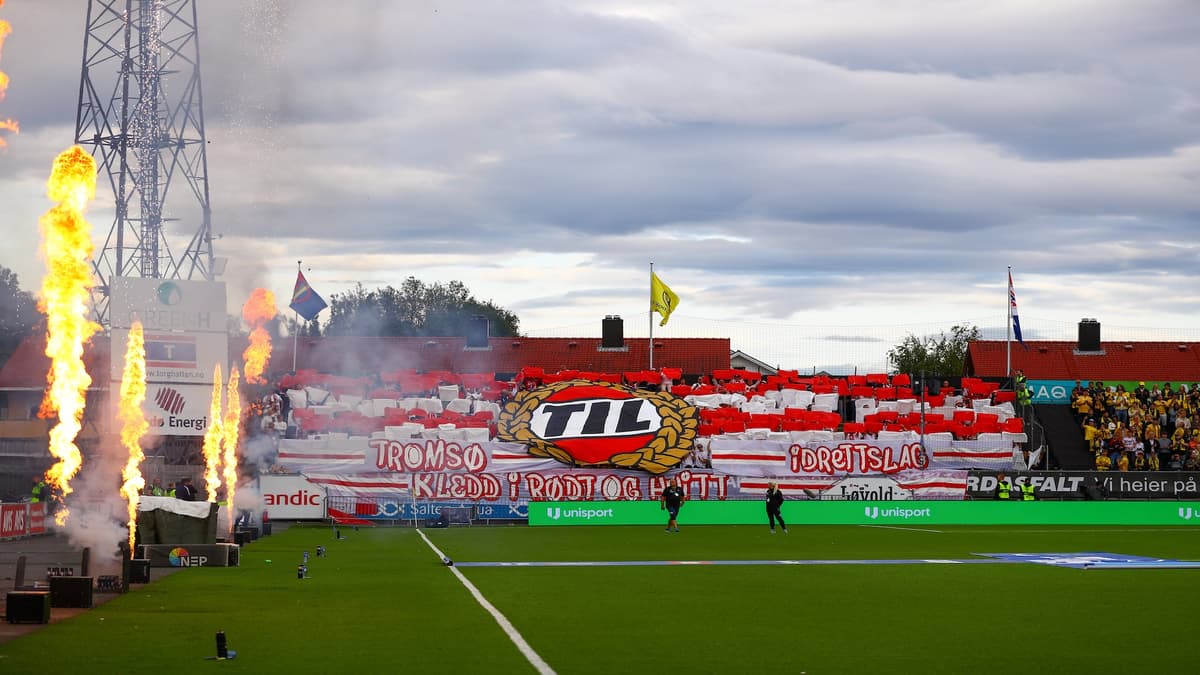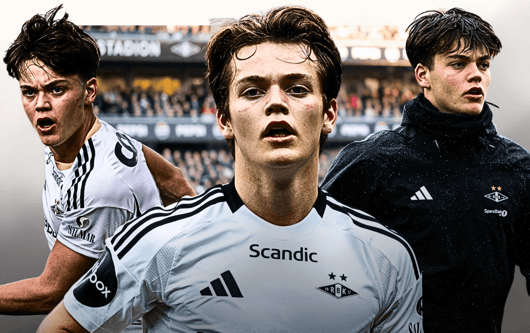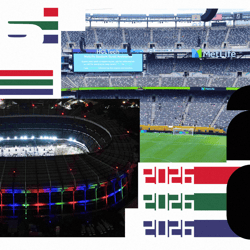-
Breaking
- 11 Jun 2025
Arctic Circle Derby: The clash between Bodo/Glimt and Tromso is a story of exclusion, isolation and a fierce football rivalry

The small Arctic town of Bodo has become accustomed to hosting football teams from around Europe.
Home to four-time Eliteserien champions Bodo/Glimt, who in 2025 became the first Norwegian team to reach a major European competition semi-final, this quiet settlement admired by hikers and adventurers has welcomed the likes of Arsenal, Roma and Ajax in recent years.
Yet for all the prestigious clubs that have taken to the artificial turf of the Aspmyra Stadion, the visit of northern rivals Tromso precipitates a reaction like no other. As Robin Gundersen, lifelong Glimt fan and resident artist in the town puts it:
"Seeing all these huge teams come to little Bodo is amazing but, of all of them, I like least to lose to Tromso."
It is a rivalry as curious as it is passionately contested, with the two clubs lying some 300 miles apart, such is the vastness of the Norwegian north.
Most supporters from Tromso fly in for this most recent derby in early August, but a hardy band - comprised almost entirely of members of the official supporter group Forza Tromso - have made the arduous journey by coach.
A ten-hour slog along the fjord-scarred coast, with little else but the shadows of the mountains for company, it is not for the faint of heart.
"There is no direct road from Tromso to Bodo, Hakon Danielsen tells World Soccer. "We drive right through the night and then halfway we have to get a ferry. With a tired grin, he flashes his smart watch that indicates the amount of sleep he got on the journey. It blinks feebly: "O hours"
Upon their arrival in Bodo, the away supporters are immediately reminded they are in enemy territory.
The town centre is dominated by a series of multi-storey apartment blocks, stark against a blissfully clear Arctic sky, and hung on the balconies from the first floor to the tenth are dozens of yellow Bodo/Glimt flags.
There is even one planted at the summit of the nearby Keiservarden, a mountainous viewpoint on the outskirts of the town popular with hikers.
Coincidentally, an arts and music festival is in full swing, and most attendees are clad in the bright yellow of Bodo/Glimt. The sports bar in the centre of town has erected a large screen and a party atmosphere is building. The Bodo players, who have breakfasted at the local Scandic Bodo Hotel, amble into the streets and pose for the occasional photograph. Such is the small size of the town, supporters and players rub shoulders with the kind of ease alien to Premier League football.
Over at Hundholmen Brygghus, the bar that has been assigned to the Tromso supporters, the owner has hung up two of his own flags above the door. With the away fans refusing to step foot in the premises, an argument soon breaks out betweer both parties. Following considerable deliberation, the proprietor bashfully removes the flags, and the TIL supporters flock to the bar.
This idea of the rivalry having an element of fun to it has diminished over the years; the success enjoyed by Bodo has intensified hostilities, especially among younger supporters. In recent seasons, they have witnessed Tromso's manager Gaute Helstrup, the club's best defender Jostein Gundersen, as well as homegrown talents like Runar Espejord, Daniel Bassi and August Mikkelsen (who has since returned) all depart for Bodo to near-universal outrage.
As Tromso captain Ruben Yttergard Jenssen succinctly puts it: "I don't like it. What if, say, Roy Keane moved from Manchester United to City? How would people feel? It's not right at all!"
During the 2024 fixture at the Romssa Arena, Felt L, the terrace occupied by Tromso's hardcore supporters, was entirely obscured for part of the game by an enormous banner depicting these defectors in prison uniform awaiting the guillotine.
But there are a few players who can get away with swapping colours. One who managed it successfully is Thomas Drage, an important fixture in Tromso's most successful era to date who later spent two seasons with Glimt. He believes he was fortunate to play for both clubs in a time when the hostilities were not so fierce.
"The rivalry has developed significantly over the last few years," he tells World Soccer. "
"Ten years ago, you could get tickets any time; now you have to be early if you want to see the match. The supporter clubs of both teams have also made tremendous strides in recent years."
The huge growth of supporter clubs like Forza Tromso and J-Feltet can be attributed to the tireless volunteers that organise away trips, mobilise supporters into corteos (when fans descend upon the ground in a procession) and help produce matchday tifos.
When Morten Killinberg, now employed directly by the club as a supporter liaison officer, founded Forza Tromso in 2013, competition was non-existent. While Tromso were recording three consecutive top-four finishes, Glimt were coming to the end of a four-year stay in the second tier. In fact, since the professionalisation of the league in 1991, the two clubs had only spent 13 seasons in the same division.
Frank Amundsen, one of the co-hosts of the highly popular Rabona podcast has been behind much of the growth associated with Bodo's supporter boom.
Famed for their tifos - from Boo the Ghost hunting a hapless Lazio-clad Luigi to a horde of Minions - J-Feltet are at the forefront of the Bodo supporter movement, spearheading the 6,000-plus that constituted the largest away following at Old Trafford in history.
Eya TIL 🔴⚪️ pic.twitter.com/gIGbUPruiR
— Josh Butler (@JoshisButler90) August 9, 2025
His opposite number, Morten, is unable to make the trip to Bodo, and so his role is occupied on this occasion by Ronny Andersen, who cuts a quiet figure amidst the pre-match raucousness of Hundholmen. At 5:30pm, 90 minutes before kick-off, the supporters empty into the streets to begin the corteo. Led by a brace of capos and ably assisted by eager drummers, this feverish parade, several hundred strong, marches a little over a mile to the Aspmyra Stadion.
The closer to the front, the more hardcore the fan. These primarily young men clutch a hand-painted banner long enough to span the width of the road and are soon lost in the shroud of red flare smoke. As the corteo approaches the stadium, it passes through pockets of home supporters. Most are cordial, some even impressed by the spectacle. There is little sense of threat. But as the away fans file into the ground, home supporters jeer from the concourses above, and a few resort to obscene gestures. The carnival atmosphere that had been present in the town is starting to ebb away, replaced by something more febrile.
When the game kicks off, both sets of supporters unveil their respective tifos:
Glimt's is a striking 20-foot rendition of forward Kasper Hogh performing his signature celebration; Tromso's a stirring display that spells out "Tromso Idrettslag: Clothed in red and white"
Everyone involved with Forza Tromso has a job. Those who have organised the tifo now hand responsibility to the capos. Situated at the forefront, these conductors - Petter Jensen chief among them - lead off on each song with the aid of megaphones, urging the crowd to maintain a near-constant barrage of noise.
"You are not here to experience the atmosphere; you are here to create it" goes the edict issued by Forza Tromso.
And it is noticed and appreciated by everyone, not least of all the players themselves.
"The fans help a lot" wing-back and Norway Under-21 international Runar Norheim tells World Soccer.
"I watch the tifos, and they make me laugh. Honestly, they're so funny. During the games, l listen to the songs when there's a break. They never stop singing, even when we aren't playing well."
Born in Finnsnes, a town located a few miles down the coast from Tromso, Norheim is as red and white as they come, having played for the club from 2020 to 2025 before sealing a move to Danish outfit Nordsjaelland this summer. For him, there is no bigger game than against Bodo:
"It's the game you want to play all season. We are two top teams now and the games have a life of their own. Even when we are losing games, we look at the calendar and we know we can beat Bodo."
In the end, the spoils are shared. A Kasper Hogh penalty is cancelled out by leltsin Camoes, but it is the Tromso fans that appear the more jubilant. As they depart the ground for their coach back north, they are still singing as the Bodo supporters file homeward in the Arctic twilight.
In a sense, the sharing of the spoils is just. Though they are divided by 300 miles, the two towns and people of Bodo and Tromso share a common identity.
They are North Norwegians, a people historically maligned by the south, and who have spent decades striving for equality. Before 1972, teams from the north weren't even allowed to compete in the Norwegian top flight. The fact that two of the top teams in Norway come from the north is some vindication for the years of discrimination.
"Not all that long ago people from the north were not allowed to work or own houses in the south", Rudi Gundersen laments. "The discrimination was very real, and though it has got better, I am glad we can enjoy this success."
Then, almost as an afterthought, he adds: "Well, Bodo's success. Hate is a strong word - I don't think I hate Tromso - but I certainly don't want them to win anything!"
And that defines the curious relationship between Bodo and Tromso. Though they are loath to admit it, they are united by their shared experiences as northerners in Norway. But when it comes to the football, you are one side or the other. Bodovœring or Tromsovœring. Yellow, or red and white. There is precious little middle ground.
Words by Josh Butler.


















